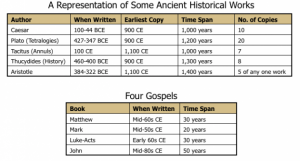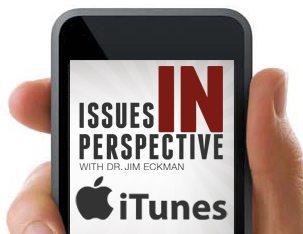Can We Trust What The Bible Says About Jesus?
May 3rd, 2025 | By Dr. Jim Eckman | Category: Christian Life, Featured IssuesThe mission of Issues in Perspective is to provide thoughtful, historical and biblically-centered perspectives on current ethical and cultural issues.

For my wife, Peggy, and me, one of our favorite pastimes is to visit our local Barnes and Noble bookstore. We spend about 60 to 90 minutes perusing the multitude of books throughout the store. I often read and skim a new book to determine if I wish to purchase it. During a recent visit, I read through the new book by religious writer Elaine Pagels, the Harrington Spear Paine (Emeritus) Professor of Religion at Princeton University. She gives focus to practice and tradition, not necessarily specific theological doctrine or content. She has done extensive research into Gnosticism and its connection to Christianity. She has argued that “belief is overrated” and that is what is most important is what we practice. Perhaps her most important book is The Gnostic Gospels.
The book I read at the bookstore is her most recent—Miracles and Wonder: The Historical Mystery of Jesus. The chapters are framed around questions (e.g., about His virgin birth, His resurrection, His kingdom, etc.). The disciples and early church arrived at “necessary fabrications” to answer these questions. And those fabrications became the doctrine of the early church. To Pagels, the four Gospels are not reliable history and are not true. They reflect what the early church wanted to believe about Jesus. In the words of Adam Gopnik, for Pagels “the Gospels are palimpsest of lore, legend, and propaganda.”
Bart Ehrman, another critic of the historicity of the Gospels, is James A. Gray Distinguished Professor of Religious Studies at the University of North Carolina. He is a much more prolific author than Pagels and is severe critic of those scholars who defend the Gospels as verifiable, trustworthy history. He, along with Pagels, represent where much of liberal theological scholarship is in 2025 when it comes to Jesus. Their books are the ones read in the mainline seminaries of the US. Their books are the ones that skeptics of Christianity read and embrace. The result is a Christianity rooted in tradition and practice, not in the veracity of the Gospels.
This reality begs the question as to whether the New Testament Gospels are trustworthy history, explaining to us who Jesus is, what He did during His three years of public ministry and that His words as recorded in the four Gospels were actually His words and not words made up by the early church. Referring to an article in the New Yorker by Adam Gopnik, columnist and devout Roman Catholic Ross Douthat summarizes where much of mainline New Testament scholarship is: “In the piece, Gopnik positions himself as a nuanced balancer between two serious schools . . . : a school that holds that the early Christians mythologized and invented, but on the basis of some set of true events; and a school that treats the historical core of Christian faith as illusory and inaccessible and the books of Mark, Matthew, Luke and John as pure literary-mystical inventions. Entirely absent is any meaningful treatment of the arguments for taking the Gospels seriously as what they claim to be: eyewitness accounts, or syntheses of eyewitness accounts, with a straightforward claim to basic historical credibility . . . [M]any Christian believers who engage seriously with their religion’s origins don’t feel like the reasonable and historically minded person is required to choose between Gopnik’s two disenchanted options. They think that the best evidence, the most serious reading of history, still makes the original interpretation as plausible as ever, and the mystery not disenchanted but intact.”
In this Perspective, I want to make the case that the Bible, and especially the Gospels, are inspired and trustworthy history. It can be trusted as truly God’s Word.
First is a summary of the authority of Scripture:
- God, who only speaks truth, has inspired Scripture to reveal Himself to rebellious humanity. It is a witness to Him and His redemptive plan centered in Jesus Christ.
- Scripture, being God’s Word, written by men and superintended by His Spirit, is of infallible authority in all matters it touches (e.g., theology, Creation, history).
- Being God-given, Scripture is without error or fault in all of its teaching.
Second, what does the Bible claim about itself? It claims to be inspired.
- The What of Inspiration, 2 Timothy 3:16: “All Scripture is inspired by God and is useful for teaching, for reproof, for correction, and for training in righteousness. . . .” [ESV]
- “Inspired” (theopneustos) means “God-breathed” or “God-spirated”
- As words come out of a person’s mouth when he or she speaks through exhaling, God has spoken—”breathed-out” His words to humankind.
- “God-breathed” brings the benefit of doctrine, reproof/correction, and instruction in righteousness
“All Scripture” that Paul refers to is the OT and, by inference, the NT documents as penned by the apostolic authors—see 1 Timothy 5:18, 2 Peter 3:16, Ephesians 3:5, 8-9 and 1 Corinthians 14:37
- 1 Timothy 5:18—Paul quotes Deuteronomy 25:4 and Luke 10:7 and calls both Scripture
- 2 Peter 3:15-16—Peter places Paul’s letters on the same level of authority as the Old Testament
- Ephesians 3:5, 8-9—Paul is proclaiming the “mystery” of God’s grace, hidden in the holy prophets and apostles but now revealed by the Spirit
- 1 Corinthians 14:37—Paul is writing at the command of the Lord
The Benefits of Scripture (2 Timothy 3:14-17)
- It “equips”—furnishes what we need in all areas
- It provides the basis for “sound”—(healthy) doctrine, which is the key to spiritual truth and growth
- It “reproves”—shows our sin and imperfections
- It “corrects”—reveals the right path to follow
- It “instructs” in righteous living.
- The How of Inspiration, 2 Peter 1:[16-19] 20-21: “First of all you must understand this, that no prophecy of Scripture is a matter of one’s own interpretation, because no prophecy ever came by human will, but men moved along by the Holy Spirit spoke from God.” [ESV]
- Peter is establishing that the apostles’ preaching about Christ is not based upon myths, but upon factual reality—see 1:16
- Peter, James and John were eyewitnesses of the future Majestic Glory of Christ on the Mount of Transfiguration—1:16b-18
- POINT of 1:20—Scripture is not a matter of the explanations of men, but it is the explanation of God Himself
- POINT of 1:21—God used human authors and has provided us with a completely reliable Bible. “Moved along,”as sailboats are moved across the water by the wind, prophets spoke under the influence of the Holy Spirit. Therefore, because the Spirit superintended the writing of the text, the message is authoritative for Christian faith and practice.
Since the Bible claims to be inspired, it necessarily invites us to test that claim.
Third, how did we get the Bible? The argument of the biblical critic is that since we do not have the original text of the Gospels, or of the Apostle Paul’s epistles, or of any other OT or NT writer, the copies that we have are not trustworthy. Furthermore, since the books of the Bible were copied by hand, mistakes were made and probably verses were added by the copiers. The result is that we really do not have a trustworthy Bible. These copiers were human and humans make errors—intentionally and unintentionally.
But, the only way people know of any ancient literature is by way of copies, not originals. The Bible is the most attested work coming out of the ancient world.
- HOW WERE THE OLD TESTAMENT BOOKS COPIED? Jewish scribes were so exact in their work that before beginning to reproduce a portion of Scripture they counted every word and every letter of the book. Every word was pronounced aloud by the scribes as they wrote them. After they finished, the words and letters were again numbered, and if the totals did not exactly correspond, the entire manuscript was destroyed and the whole process repeated. Did this process preserve the accuracy of the OT text? Before 1947, the English translations we have were based on Hebrew texts from about AD 900. The Dead Sea Scrolls, discovered in the 1947, have OT texts from about 100 BC. Among the scrolls, the text of Isaiah, for example, is virtually identical. That is 1,000 years of accurate preservation!
- HOW WERE THE NEW TESTAMENT BOOKS COPIED? In what was called a scriptorium, the NT books were copied in virtually the same manner as OT texts described earlier. All work was then checked by a “Corrector,” specifically trained to rectify mistakes in copying. Today, we have over 5,800 copies of Greek NT manuscripts. (Indeed, there are between 20,000 and 25,000 handwritten copies of the NT in various languages). The total of these Greek NT copies agree over 90%+ of the time and, where there is disagreement (in a different letter or word), Christian doctrine is not affected. The accuracy of these is continually being validated by papyri, small fragments of NT books, which are often from the early 2nd into the 3rd centuries. Between 10 to 15 of these NT papyri manuscripts were written within 100 years after completion of the NT. They confirm the accuracy of the NT text.
The result is that we have more copies of the Christian Scriptures than we do of any other ancient text: The gap between the originals and the early manuscripts is relatively slim (decades in some cases and only 100+ years in others). By comparison, the average classical author has no copies for more than half a millennium. Comparing the NT text to some better-known ancient authors, it still has no equal. If one is skeptical about what the original NT text said, that skepticism needs to be multiplied many times over when it comes to the writings of all other ancient Greek and Latin authors.

Finally, can we trust that the Bible, especially the Gospels, is trustworthy history? There are several important reasons why we can.
- The canonical Gospels were written between 20 and 60 years after Jesus’ death, burial and resurrection—Matthew, late 50s, early 60s; Mark, late 40s, mid-50s; Luke, early 60s; John, after AD 70, probably in the 80s. Paul’s letters were written between 15 and 25 years after Jesus. [The Gnostic gospels were written 175 AD at the earliest (e.g., Gospel of Thomas).]
Thus, there were still numerous well-known living eyewitnesses to Jesus’ teaching and life. The Gospel writers used these witnesses as sources to establish authenticity (e.g., Luke, Mark 15:21; 1 Corinthians 15:1-6, etc.).
- The content is far too counterproductive for the Gospels to be legend. Why would leaders make up the story of the crucifixion if it did not happen? Why make up an account of Jesus praying in the Garden of Gethsemane if he could get out of the mission? Why ever make up the part of Jesus crying out to God the Father who then abandons him? Why invent a woman as the first eyewitness of the resurrection? Why depict the disciples as petty, jealous, cowards who either actively or passively abandoned Jesus? Why make Peter such a dismal failure, even to the point of cursing his master (Mark 14:71)? Further, the Gnostic gospels affirm the Greco-Roman worldview, while the Gospels challenge that worldview at every level.
In conclusion, consider the words of Jesus in Matthew 5:17-18: “Do not think that I came to abolish the Law or the Prophets; I did not come to abolish but to fulfill. For truly I say to you, until heaven and earth pass away, not the smallest letter or stroke shall pass away from the Law, until it is all accomplished.” [ESV]
- The smallest Hebrew letter is a Yodh, similar to an apostrophe in English.
- A “stroke” is the stroke of a stylus (a pen). It is the difference between EAT and FAT in English.
- You can have no higher view of Scripture and its authority than that of Jesus.
For additional evidence as to why we can trust the Bible, see Andreas Kostenberger, Darrell Bock and Josh Chatraw, Truth Matters: Confident Faith in a Confusing Word.
See Ross Douthat, “Why Historically Minded Believers Still Find the New Testament Credible,” NYTimes.com (28 May 2025).


